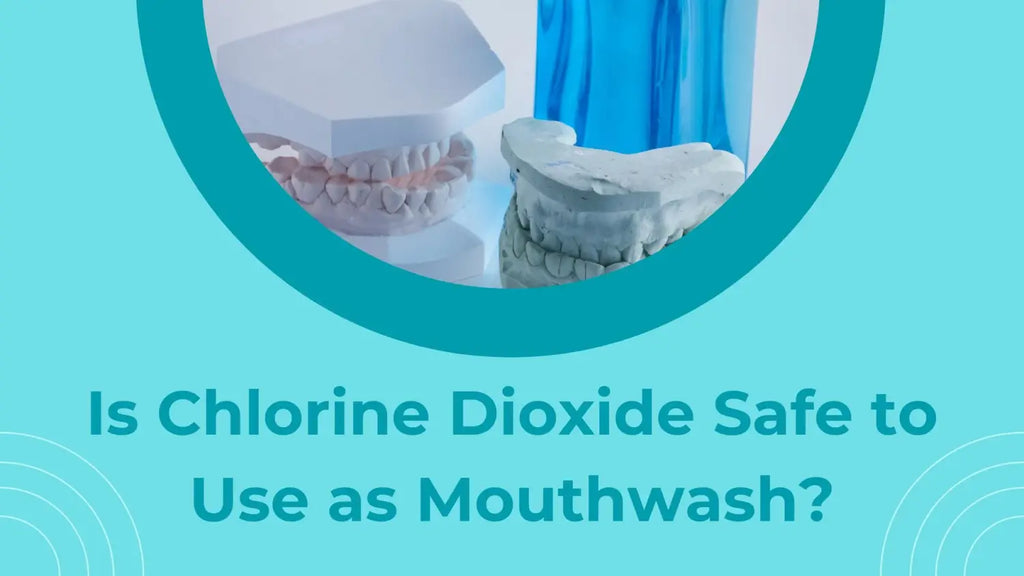Is Chlorine Dioxide Safe to Use as Mouthwash?
Posted by WISHPOND - DREAMTEAM

Is Chlorine dioxide really as beneficial as they say?
There have been many studies that suggest that this chemical is really a multipurpose disinfectant that is even safer than chlorine and bleach. But just how versatile is this disinfectant?
What is Chlorine Dioxide?
Chlorine Dioxide is a disinfectant, commonly used to purify drinking water. It is very safe in small quantities and can be used in the household for disinfecting produce, cleaning and sterilizing medical equipment, and even in the production of paper making.
Another excellent household use of chlorine dioxide is as a mouthwash. Now, unlike bleach, chlorine dioxide is also safe to use as a mouthwash. But how exactly should it be used, and how does it help with oral health and hygiene?
Let’s take a look at what causes these issues to begin with.
What causes bad oral health?
Oral health and hygiene is essential to the overall health of your body. Poor oral hygiene leads to issues with oral health such as cavities, gum disease, gingivitis and plaque. Some of these issues have also been linked to other health problems such as cancer, diabetes and heart disease.
Not following good oral hygiene practices can lead to a myriad of oral issues.
Some of these include:
- Bleeding or swollen gums
- Oral ulcers
- Chronic bad breath
- Receding gums
- Sensitive teeth
- Cracked or broken teeth
- Toothaches and pain
Maintaining good oral health includes the practice of brushing with toothpaste at least twice daily, flossing at least once daily, limiting sugary drinks and foods, and topping off your clean with mouthwash. One ingredient that could really boost mouthwash to give you an ever better clean is chlorine dioxide.
Is chlorine dioxide safe in mouthwash?
One of the symptoms of poor oral health is chronic bad breath. Chlorine dioxide is known to eliminate the bacteria that causes bad breath, but the big question is how safe is it for use?
Odours are caused by compounds that contain sulphur bonds in their molecule structure. Chlorine dioxide is able to safely and effectively break down the volatile sulphur compounds that help to contribute to bad breath. By breaking down these bonds, Chlorine dioxide is able to eliminate their ability to produce odour.
Studies have shown that Chlorine Dioxide is effective at significantly reducing oral malodour in as little as two weeks after use. Additionally, it is also effective in decreasing tongue coating and the negative bacteria that are key agents in producing bad breath.
Another positive effect of using Chlorine dioxide as a mouthwash is that it does not have the same burning effect that mouth rinses with alcohol has. This means it is great for people with more sensitive mouths, as it tends to be a lot more gentle.
How to use chlorine dioxide mouthwash
Many of the most popular mouthwashes on the market contain chlorine dioxide, so this isn’t new or strange. If your mouthwash has chlorine dioxide as an ingredient, ensure the quantity does not exceed the recommended dose of .8 milligrams per litre.
After you have finished brushing your teeth, take the cap of the mouthwash bottle and use a small amount to swish around in your mouth for 30 seconds before spitting. Do not swallow!
Essentially, Chlorine Dioxide is a powerful tool in the fight against poor oral health and bad breath. So search for mouthwashes that contain chlorine dioxide and enjoy fresh breath!


Colin On
To use as a mouthwash, keep this in mind. With the plastic turret cap and external plastic dropper, 1 drop of the solution added to 1 litre of water results in a Chlorine Dioxide concentration of 0.15 parts per million (ppm). So you would do the maxim it says on the bottle 5 drops per liter of water. For the WPS KIT 2 drops per gallon to get about 0.8 milligram per litter of water.
buck On
do you have a recipe to get .8milligram per litre, using the WPS kit 25% & HCL for mouthwash ?